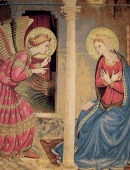Book Review: Thanks to Paul, we have inherited the Church
Article:
01.03.19
Thanks to Paul, we have inherited the Church
Paul: A Biography by N. T. Wright, HarperOne, 464pp, UK £12.99 (paperback), US $20.39 (hardback).
reviewed by Sister Mary Dominic Pitts
Imagine a book-length treatise on the life and writings of Paul the Apostle, derived from years of theological, sociological and historical research. Imagine this treatise delivered in the thoughts and speech and actions of Paul and his companions, all in lighthearted modern language. Imagine all of the foregoing and you have N.T. Wright’s newest work, Paul: A Biography.
Contextualizing Saul’s sudden appearance in Acts, the author gathers together Paul’s self-reported biographical facts—his prized Roman citizenship (Acts 16:37 22:22-29), his study under the great Rabbi Gamaliel, his upbringing as a Pharisee anticipating Israel’s glorious end times, and his deeply rooted desire to destroy the “followers of the Way”—and combines them in a portrait of the zealous young Jew who becomes one of the most remarkable men in Christian history. In a powerful narration of the conversion on the Damascus Road, Wright imaginatively transforms the blinding “light from the sky” (Acts 9:3) into the mystical chariot of the prophet Ezekiel. Our eyes travel upward with Paul’s as he hopes to see “the [God] he has worshipped and served all his life”—and we, with Paul, come “face-toface with Jesus of Nazareth” (p.53).
What Paul meant
Wright has a gift for debunking false modern ideas with historical evidence of what terms and concepts would have meant in the first century. Heaven consists not of “being rescued by Jesus from the world and taken to a distant heaven, but [of] the coming together of heaven and earth in a great act of cosmic renewal in which . . . Jesus will come to transform the present world and us with it” (p.8). The “conversion” on the Road to Damascus is in fact an expansion of the Jewish telos. Gentiles have to be convinced that the Jewishsounding “covenant faithfulness” does not undermine the Roman Empire but brings about a shift of universal lordship from Caesar to Christ (p.106). “Miracles” worked through St. Paul on his journeys are not a divine “invasion” into nature but the “Creator himself at work in a fresh way” (p.122). Paul’s speech at the Areopagus is not a confrontation with dilettante philosophers but Paul’s desperate selfdefence before the Athenian high court in the face of the danger of arrest and even execution (p.196).
The author has a particularly delightful gift for vivid metaphors to capture his points. For example, Paul is depicted as walking a “tightrope over [a] volcano,” and continues, “If we can think of a world without music and then imagine it being invented . . . we may have a sense of the crazy magnitude of Paul’s vocation” (p.109). The abandonment of idols for the “living God” is like giving up gambling for regular church attendance.” Its impact is “to give up all our usual machines and conveniences: car, cell phone, cooking equipment, central heating, or air-conditioning. You would have to do everything differently” (pp.110- 111). Luke’s omitting the outcome of “the collection” for Jerusalem is like “people watching all but the last ten minutes of a great sporting event . . . when a sudden power outage stops us from find out who won” (p.350).
The theology comes alive
For this reader, the book’s most powerful achievement is its fresh unfolding of the full realities of problems, persecution and misunderstanding that arise in Paul’s new Christian communities. In a series of outstanding chapters, the cause of the “daily pressure on me, my care for all the churches” is traced directly to enemies in Corinth and Ephesus (p.315). Wright attributes the two powerful Christocentric hymns—Philippians 2: 6-11 and Colossians 1:15-20—to Paul’s dark night during the two years of his imprisonment. The same prison ordeal is made to account for the descent into sadness in 2 Corinthians after the brisk advice in the first epistle. A chastened Paul emerges to urge quarrelling churches in Philippi and Colossae to imitate Jesus’ divine self-emptying and to worship Jesus as Lord of the universe. To unite the Jewish and Gentile house churches in Rome, Paul produces Romans, the great epistle of systematic Christology theology, with its theme that “God has shut up all people in disobedience, so that he may have mercy upon all” (p.335). In Wright’s own translation of the Scriptures, the eloquent Greek of the epistles is transformed into equally eloquent modern English accessible to the reader.
Jesus has won the messianic victory
In the end, Wright powerfully sums up Paul’s realization that “Jesus is the image, the truly human one at the heart of the world-temple, the one who straddles heaven and earth, holding them together at last, the one whose shameful death has reconciled all things to the Creator” (p.291). From the Acts of the Apostles and Paul’sepistles, the author pieces together Paul’s interior and exterior lives, his maturing theology and his missionary journeys to spread the eschatological truth that Jesus is at once the fulfillment of Israel’s hopes and expectations and the unlooked-for salvation of the Gentiles. We follow Paul’s struggle with initial resistance and even, in his final hard-won victory, his anxiety that there must be “no barriers between Jewish Messiah people and non-Jewish Messiah people, [for] to erect such barriers would mean denying that Jesus had won the messianic victory” (p.79).
In Paul: A Biography, N.T. Wright portrays with brilliant simplicity the story of Paul’s role in about the Church as we know it today. The book follows the expansion of Christianity from the original Messiahpeople into diverse communities of believers spanning the known world of the first century. We have inherited this Church, thanks to Paul.
Notes:
Sister Mary Dominic Pitts, a Dominican sister of the Congregation of St. Cecilia, teaches at Aquinas College in Nashville, Tennessee.





